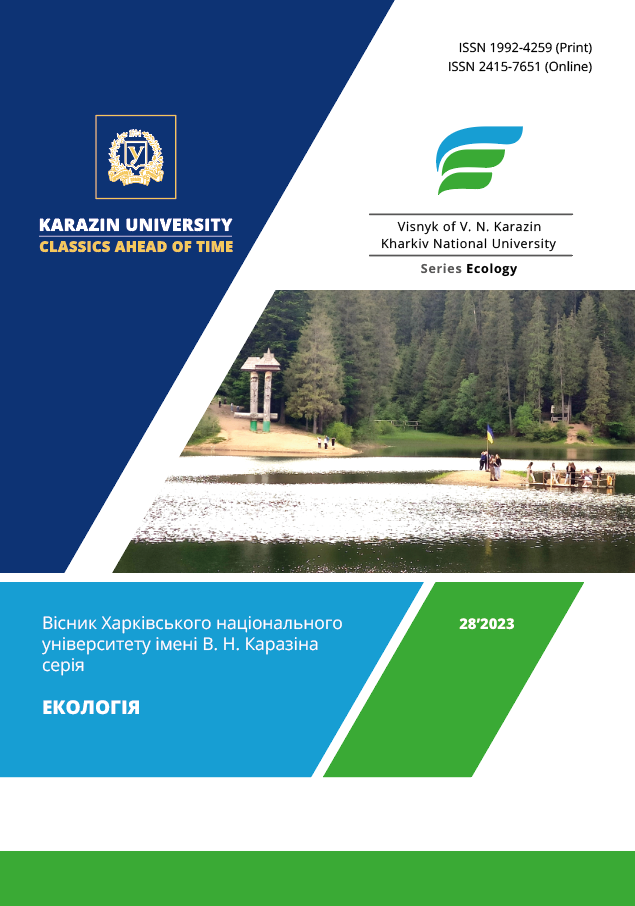Natural and historical aspects of the environmental monitoring in the city of Lviv
Abstract
Purpose. To study the natural-historical aspects of the organization of monitoring the components of the natural environment in the territory of the city of Lviv, to identify the peculiarities of its organiza-tion at different historical stages of the functioning of the urban system, to highlight the specifics of the organization of environmental monitoring in modern conditions.
Results Regular meteorological observations with the help of instruments began in Lviv in 1811, and observations and descriptions of the city's vegetation were carried out in the 1950s. Ya. Lagner. In 1944, the Department of Hydrometeorological Service of the Carpathian Military District was organized in Lviv. It included: weather bureau, group of hydrological forecasts, group of restoration of the network of stations. At the beginning of 1946, on the basis of this department, a hydrometeorological office was creat-ed, which since 1959 functioned as a hydrometeorological observatory (HMO) with groups: meteorologi-cal, hydrological forecasts and agrometeorological. In 1964, the Lviv Aerological Station became part of the GMO under the authority of the Aerology Department. Old, historical Lviv was located in the middle of large forests, had many streams, brooks, as well as rich flora. Such diversity is determined by the geo-graphical location, the history of the formation of the relief and climatic conditions in previous geological periods. The study of the landscape-natural primary basis in comparison with the built-up areas leads to the demarcation of the urban environment based on belonging to a certain type of natural landscape and thereby determines different approaches to its transformation. Background observation points located at nature conservation facilities provide information about the state and changes in the natural environment that occur outside of human activity. A comparative analysis of similar indicators obtained in areas with different degrees of urban influence will make it possible to reveal the real state of anthropogenic changes, identify their causes, predict the further consequences of urbanization, as well as build models of such social and production systems that would be the least harmful to the environment.
Conclusions. Environmental monitoring in the territory of the city of Lviv has a long history. Moni-toring the state of the atmospheric air, water environment, biodiversity was and remains an important component in the issue of the quality of the urban environment and does not lose its importance. Environ-mental monitoring must be considered as an integral part of the regional management system of nature management, which must perform the target functions of continuous observation and forecasting of the main socio-ecological processes for the purpose of their analysis, identification and identification of the main factors for the preparation and adoption of management decisions.
Downloads
References
Babichenko, V.M., Zuzuka, F.V. (Eds.). (1998). Climate of Lviv. Lutsk. (In Ukrainian).
Golubets, M.A. (2010). Environmental science (environmentology). Lviv: Manuscript. (In Ukrainian).
Tatarynov, K.A. (1991). Fauna of the urban environment and ecological adaptations of species. Pro-ceedings of the scientific and practical conference: Problems of urban ecology and phytoremediation. (Lviv, 1991, September 10-12, p.33). Lviv. (In Ukrainian).
Volgin, S.O., & Zelenchuk A.T. (1994). Synanthropization of flora as an indicator of anthropogenic transformation of Lviv ecosystems. Proceedings of the scientific conference: Urbanization as a factor of changes in the biogeocenotic cover. (Lviv-Yaremcha, September 21-23, 1994. pp. 21-23.). Lviv. (In Ukrainian).
The state of the environment in the Lviv region (according to the results of monitoring studies). (2020). Informational and analytical review for the 3rd quarter of 2020. Department of Ecology and Natural Resources of the Lviv Regional State Administration. Lviv. (In Ukrainian).
Nazaruk, M.M. (2008). Lviv in the 20th century: socio-ecological analysis. Lviv: Publishing Center of Ivan Franko National University of Lviv. (In Ukrainian).
The level of atmospheric air pollution in the city of Lviv. Retrieved from https://www.saveecobot.com/maps/lviv
Resolution of the Cabinet of Ministers of Ukraine of August 14, 2019 No. 827 «Some issues of state monitoring in the field of atmospheric air protection» (2019). Retrieved from https://zakon.rada.gov.ua/laws/show/827-2019-%D0%BF#Text (In Ukrainian).
Resolution of the Cabinet of Ministers of Ukraine of March 9, 1999 No. 343 «On approval of the Pro-cedure for organizing and conducting monitoring in the field of atmospheric air protection». (1990). Retrieved from https://zakon.rada.gov.ua/laws/show/343-99-%D0%BF#Text (In Ukrainian).
Order of the Ministry of Environmental Protection and Natural Resources of Ukraine. N 147 of April 21, 2021 «On approval of the form of the State Monitoring Program in the field of atmospheric air pro-tection». (2021). Retrieved from https://ips.ligazakon.net/document/RE36165 (In Ukrainian).
State monitoring program in the field of atmospheric air protection for 2021-2025 of the Lviv zone (2021, 8 December). Retrieved from https://deplv.gov.ua/2021/12/08/zatverdzheno-programu-derzhavnogo-monitoryngu-u-galuzi-ohorony-atmosfernogo-povitrya-na-2021-2025-roky-lvivskoyi-zony/ (In Ukrainian).
Copyright (c) 2023 Назарук М. М., Бота І. В.

This work is licensed under a Creative Commons Attribution 4.0 International License.
Authors who publish with this journal agree to the following terms:
- Authors retain copyright and grant the journal right of first publication of this work under the terms of a license Creative Commons Attribution License 4.0 International (CC BY 4.0).
- Authors are able to enter into separate, additional contractual arrangements for the non-exclusive distribution of the journal's published version of the work (e.g., post it to an institutional repository or publish it in a book), with an acknowledgement of its initial publication in this journal.
- Authors are permitted and encouraged to post their work online (e.g., in institutional repositories or on their website) prior to and during the submission process, as it can lead to productive exchanges, as well as earlier and greater citation of published work.





